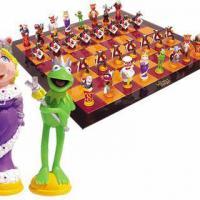
The Bishop's Show: King Activity
We continue our series on bishop endgames and today's topic is king activity in bishop endings. Getting the king into the center should be an aim in most endgame positions. Usually, in bishop endgames the defending side can block the opposing king's advancement with their own king. Having an active king does not win the endgame on its own but it helps to use auxiliary ideas such as pawn breaks and bishop sacrifices. The latrer are especially effective when there is the presence of a "bad bishop." When the pawns and the bishop are on the same color and cannot guard the squares of the other color, they leave a perfect route for the opponent's king. In this article our main goal is to learn a pattern of combining a bishop sacrifice with king activity, and to plan for it from far away despite the presence of the other pieces.
With the next set of positions we will look at how to break through the position where the opponent's king stopped ours from moving forward. The level of complexity increases as we go forward. In the first endgame black has a "bad bishop" - the topic of the last article but his position is solid because the king and the bishop covered all the entrance squares. The only passed pawn is safely stopped by the bishop on d6. It looks like black is in no danger but white finds a crushing bishop sacrifice that allows the king to get into black's camp and help the pawns to promote.
The next example features the same idea but in combination with a pawn break. The evaluation of the position is not as clear as in the previous example. For example, both sides have pawns on the color of the bishop. Black's bishop cannot really be called a "bad bishop" and black's king is as active as white's. The two advantages that white has-- and they are sufficient ones-- are an extra pawn and the passed f-pawn. The pawn break d4 does not achieve much yet but it always hangs in the air, so black has to be careful.
Now that we are familiar with the pattern of bishop sacrifice to clear the road for the king, we can look into endgames that have not reached the bishop endgame yet but have other pieces present too. In the following example black has a "bad bishop" and less space, where his only advantage is an active rook. White sets his sights on exchanging the only active piece in black's arsenal, after which the king activity is felt even more. For now white cannot expose the king too much because the rook can attack it with a series of checks but when the rooks are traded white will have more flexibility in using the advantage of the active king.
In the next game, when black doubled rooks on the d-file he had in mind a favorable endgame after their exchange. Black's poor pawn structure on the kingside is fully compensated by his advanced pawn chain on the queenside. The bishop on f1 is limited by the c4-pawn as well as by his pawns on the kingside. If white plays carefully, keeping the king in the centre black will not be able to do much because of the doubled f-pawns. However, white decided to "activate" the king by means of first bringing it to the edge of the board. This won black time to achieve a now-familiar idea.
Today we looked at endgames where one side had an active king but could not use this advantage without a bishop sacrifice. The sacrifice cleared the way for the king and deflected the opponent's king. We then practiced seeing this pattern from afar when there were other pieces present. The topic of king activity is so broad that with today's article we only brushed the surface of it. Next week we will look into how it can be used effectively in combination with other patterns.






